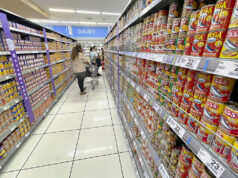Inflation hits fresh 9-year high in Sept

By Melissa Luz T. Lopez, Senior Reporter
INFLATION surged anew in September to a fresh nine-year high as the strong typhoon which hit last month worsened supply issues for rice and other crops, spurring calls for further interest rate hikes from the central bank.
Prices of basic goods and services jumped by 6.7% in September, surging from 6.4% in August to mark the ninth straight month of increase, the Philippine Statistics Authority (PSA) said on Friday.
The rate soared from three percent in September 2017, and falls just below the 6.8% median forecast from a BusinessWorld poll as well as the estimate given by the Bangko Sentral ng Pilipinas (BSP).
This is also the fastest pace logged since the 7.2% climb recorded in February 2009, and brings the nine-month average to 5%, an entire percentage point higher than the state’s 2-4% target and still below the 5.2% BSP forecast for the full year.
National Statistician Lisa Grace S. Bersales said in a press briefing that the biggest price increases were seen for food and non-alcoholic beverages, which jumped to 9.7% from 8.5% the previous month, followed by transport (8%), and housing, water, electricity, gas and other fuels (4.6%).
In particular, rice prices surged to 10.4% coming from 7.1% in August at a time of scarce supply of cheap rice.
“Supply disruptions caused by the onslaught of Typhoon Ompong in the regions of Ilocos, Cagayan, and Cordillera Autonomous Region put upward pressures on food prices,” President Rodrigo R. Duterte’s economic managers also said in a joint statement issued on the same day.
Typhoon Ompong affected nearly three million residents, left 68 people dead, 138 injured and two missing, according to NDRRMC’s Oct. 1 situation report. The heavy rains also caused P26.77 billion worth of damage to agriculture and P6.923 billion to infrastructure.
Mr. Duterte placed the hard-hit regions I, II, III and the Cordillera Administrative Region under state of calamity to put in place price controls and “provide some needed relief” to affected residents, the economic managers noted.
Unrelenting world crude prices also kept prices elevated, the Cabinet officials added.
Month-on-month inflation came in at 0.9% in September. Core inflation, which excludes goods with volatile prices, clocked in at 4.7% from 4.8% in August.
Breaking the trend is the cost of education which declined for the third straight month reflecting the impact of the free tuition law for state universities and colleges, Ms. Bersales said
By area, inflation clocked in faster in the provinces to average 6.8%. In particular, prices saw the biggest leap in the Bicol region at 10.1%. The PSA said this was largely due to a sharp rise in the cost of rice, vegetables, oils and fats, as food prices in the region surged by 14.6%.
Meanwhile, basic goods in Metro Manila saw prices increase by 6.3% as the cost of housing and utility rates rose by 4.2%, slower than the 7.8% pace in August.
PEAK REACHED
Both the President’s economic team and the BSP believe that inflation will be on a downtrend following the fresh multiyear high last month.
“Barring unforeseen events in the last quarter of the year, we could have seen the peak of inflation in recent period and initial signs of disinflationary trend through 2020,” BSP officer-in-charge Deputy Governor Diwa C. Guinigundo said in a text message.
The economic team also noted “clear signs of easing” that inflation will taper off by yearend, adding that the “speedy passage” of the Rice Tariffication bill would pave the way for the “earlier return” to below four percent, as it would raise the supply of cheap rice and ease the burden for hungry Filipinos.
However, one analyst said skyrocketing prices will likely dampen economic growth during the third quarter.
“Higher inflation/prices tends to reduce the purchasing power and spending of households/consumers, which account for about 70% of the local economy, thereby could lead to slower growth in demand for affected goods and services, as well as slower growth in the broader economy,” said Michael L. Ricafort, economist at the Rizal Commercial Banking Corp.
“As a result, higher prices and higher interest rates could lead to slower economic growth in 3Q 2018.”
The Duterte administration believes growth could recover during the third quarter following a disappointing six percent climb from April-June, even as the 7-8% goal for the entire year may be hard to achieve.
MORE HIKES?
Market watchers said the BSP would still need to hike interest rates further in order to keep local yields competitive and rein in price expectations.
“Bringing inflation below 4.0% target will require further tightening, in our view,” ANZ economists Shashank Mendiratta and Sanjay Mathur said as they see a 25 basis points (bp) increase in the benchmark interest rates.
Nomura’s Euben Paracuelles is more hawkish, as he expects a cumulative 50bp hike this quarter and another 50bp by the first quarter of 2019 to lift rates from negative territory.
In contrast, senior economist Nicholas Antonio T. Mapa from the ING Bank N.V. Manila Branch said there is a smaller chance for a 25bp hike in November, although the BSP is seen to stand ready for further action if needed.
For his part, BSP’s Mr. Guinigundo gave hints that it may be “too early to comment” on their next moves as they await more economic data.
“In general, the BSP will remain vigilant with strong tightening bias until such time that we are certain inflation can be sustained within the target range of 2-4 percent for 2019 and 2020,” the central bank official said.
The BSP will hold its seventh rate-setting meeting this year on Nov. 15. The central bank has already raised benchmark yields by a cumulative 150bps since May to douse inflation expectations and show a strong hand to commit to temper consumer prices.



